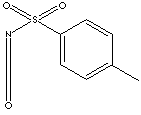| p-TOLUENE
SULFONYL ISOCYANATE
|
||
|
PRODUCT IDENTIFICATION |
||
| CAS NO. | 4083-64-1 |
|
| EINECS NO. | 223-810-8 | |
| FORMULA | CH3C6H4SO2NCO | |
| MOL WT. | 197.21 | |
|
H.S. CODE |
||
|
TOXICITY |
Oral rat LD50: 2234 mg/kg | |
| SYNONYMS | Tosyl isocyanate; PTSI; | |
| 4-Isocyanatosulphonyltoluene; 4-methyl-Benzenesulfonylisocyanate; para-Tosyl isocyanate; 4-Toluenesulfonyl isocyanate; Isocyanic acid, anhydride with p-toluenesulfonic acid; p-Toluolsulfonylisocyanat (German); Isocianato de p-toluenosulfonilo (Spanish); Isocyanate de p-toluenesulfonyle (French); | ||
| SMILES | ||
|
CLASSIFICATION |
|
|
|
PHYSICAL AND CHEMICAL PROPERTIES |
||
| PHYSICAL STATE |
clear liquid |
|
|
MELTING POINT |
5 C | |
| BOILING POINT | 275 - 278 C | |
| SPECIFIC GRAVITY | 1.290 -1,295 | |
|
SOLUBILITY IN WATER |
Reacts | |
| pH | ||
| VAPOR DENSITY | 6.80 | |
|
REFRACTIVE INDEX |
1.5340 | |
| NFPA RATINGS | Health: 2; Flammability: 1; Reactivity: 2; Special Hazard: -W- | |
| FLASH POINT |
145 C |
|
| STABILITY | Stable under ordinary conditions. Moisture sensitive | |
|
GENERAL DESCRIPTION & APPLICATIONS |
||
Cyanic acid
(the isomer of fulminic acid) is an unstable (explosive), poisonous, volatile,
clear liquid with the structure of H-O-C��N (the oxoacid formed from the
pseudohalogen cyanide), which is readily converted to
cyamelide and fulminic
acid. There is another isomeric cyanic acid with the
structure of H-N=C=O, called isocyanic acid. Cyanate group (and isocyanate group) can react with itself.
Cyanuric acid (also called pyrolithic acid), white monoclinic crystal with
the structure of [HOC(NCOH)2N], is the trimer
of cyanic acid. The
trimer
of isocyanic acid
is called biuret.
Cyanic acid hydrolyses to ammonia and carbon dioxide in water. The salts and esters of cyanic acid are cyanates. But esters of normal cyanic acid are not known. The salts and esters of isocyanic acid are isocyanates. The isocyanate group reacts with the hydroxyl functional group to form a urethane linkage. Diisocyanates (or polyisocyanates) are monomers for polyurethane production. Polyurethane is made from a variety of diisocyanates in conjunction with polyether and polyester polyols as co-reactants by addition polymerization which needs at least two -N=C=O groups. Polyurethanes are widely used in the manufacture of flexible and rigid foams, fibres, coatings, and elastomers. If isocyanate monomer is polymerized with amine group, polyurea is produced. Cyanates (or Isocyanates) are readily reacts with various form of amine (including ammonia, primary-, secondary-amines, amides and ureas) and hydroxyl functional group. They are used in the synthesis for the target molecules such as pharmaceuticals, pesticides, textile softener, lubricants and industrial disinfectants. They can convert to polycyclic compounds such as hydantoins and imidazolons. They are used as plastic additives and as heat treatment salt formulations for metals. p-Toluenesulfonyl Isocyanate is used as a water scavenger in urethane products. End application include adhesives, coatings and sealants. It is also used as an intermediate in organic synthesis. |
||
| SALES SPECIFICATION | ||
|
APPEARANCE |
clear liquid |
|
|
Assay (GC) |
98.0% min | |
|
SUM IMPURITY |
2.0% max | |
| TRANSPORTATION | ||
| PACKING | 200kgs in drum | |
| HAZARD CLASS | 6.1 (Packing Group: II) | |
| UN NO. |
2206 |
|
| OTHER INFORMATION | ||
| Hazard Symbols: XN, Risk Phrases: 14-36/37/38-42, Safety Phrases: 26-28A-30 | ||
| GENERAL DESCRIPTION OF TOSYL | ||
|
The term of tosyl is for p-toluene sulfonic acid ester functional group, the conjugate base of the strong acid, p-toluenesulfonic acid. The tosyl group, like other sulfonates, has electron-withdrawing properties. It is a highly reactive leaving group due to the stability of resonance structure. It has a distributed negative charge rather than a localized charge. Each oxygen atom bears one-third of the total negative charge. The tosyl group serves as a protecting group which is readily cleaved. Toluene sulfonic acids and their derivatives are used as intermediates for the synthesis of isocyanate compounds used as water scavengers and catalysts for the production of thermosetting resins. p-Toluene sulfonic acid is often used as a catalyst in the formation of acetal which water must be removed from the reaction mixture to escape reversible reaction. Water is removed azeotropically by distilation. (Toluene is the solvent). |
||
